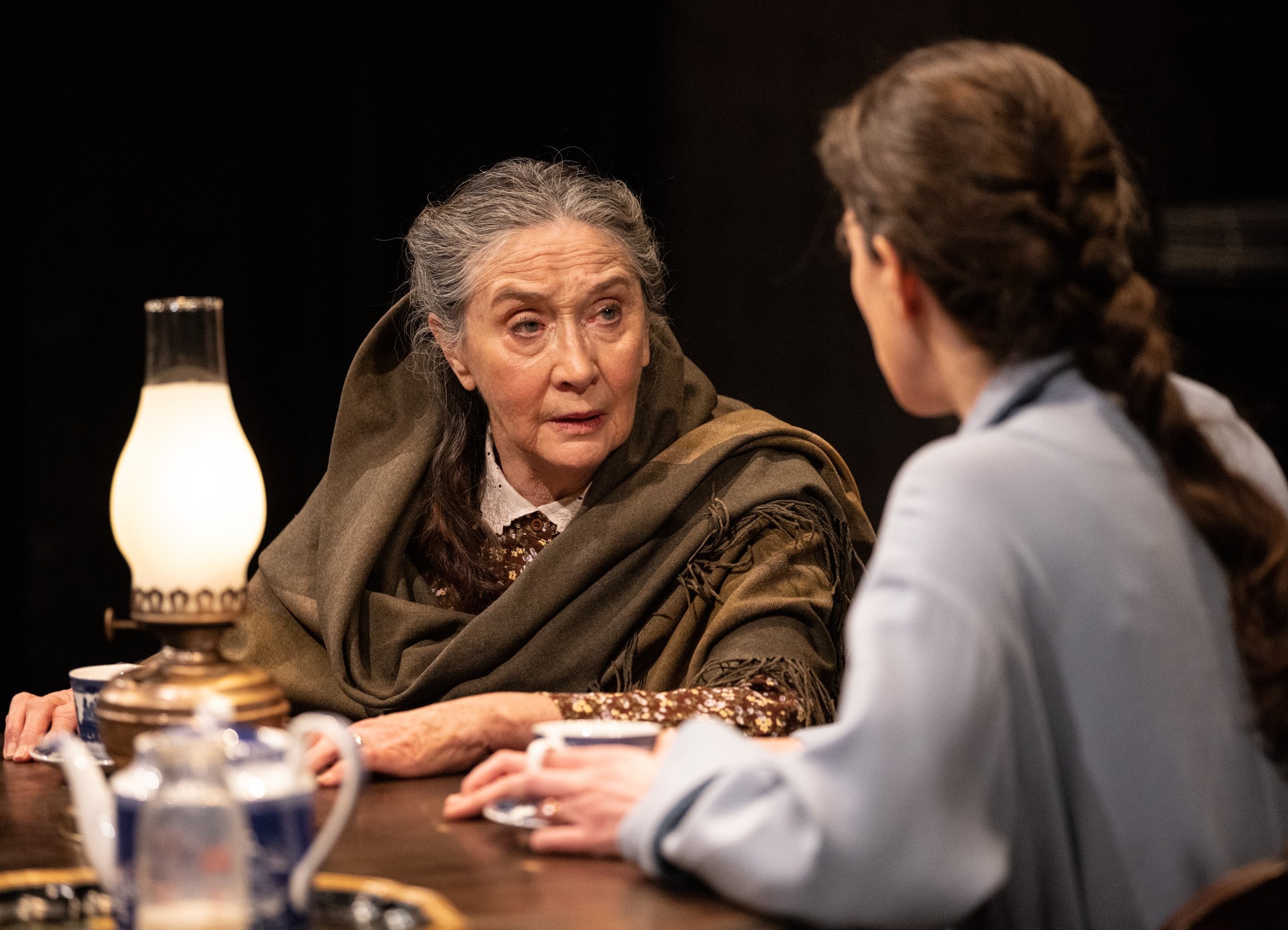Minnie Gascoyne (Amy Blackman, right), the namesake daughter-in-law of D. H. Lawrence’s play, with her husband Luther (Tom Coiner), who has been roughed up during a labor dispute.
D. H. Lawrence wrote The Daughter-in-Law in 1912–13, at the age of 27, around the same time as his novel Sons and Lovers. The play’s first production came posthumously, in 1967. There have been very few productions since, one of which was by the Mint Theater Company, in 2003, fulfilling its mission to “find and produce worthwhile plays from the past that have been lost or forgotten.” Now Martin Platt, who directed that production, again takes the reins for the company’s revival of The Daughter-in-Law, currently playing at City Center Stage II.
One of the play’s challenges is that, as explained in the program, it is written in an East Midlands dialect, which can sound a bit like Old English. The play’s opening line is “Well, I s’d ha thought thy belly ’ud a’browt thee whoam afore this.” The program contains a glossary that is helpful to read beforehand (e.g., clat-fart, gossip; wallit, clumsy).
Mrs. Gascoyne (Sandra Shipley) shares tea with her daughter-in-law Minnie.
The Daughter-in-Law centers on an unhappily married couple, Luther (Tom Coiner) and Minnie (Amy Blackman), and their relationship with Luther’s family: his mother, Mrs. Gascoyne (Sandra Shipley), and brother, Joe (Ciaran Bowling). The sociopolitical context is the Great Unrest, a period of labor revolt in the United Kingdom in the early 20th century. Luther and Joe work in the coal mines of Eastwood, Lawrence’s hometown, and a workers’ strike is imminent. The romantic couple’s conflict is one of social class, much like Lawrence’s own parents: his father, like Luther, a “barely literate miner,” and his mother, like Minnie, with some education and “middle-class aspirations.”
The first act’s opening scene takes place in Mrs. Gascoyne’s small kitchen, where she and Joe discuss his attempts to get accident pay for his broken arm. Both Shipley and Bowling are superb here—funny and natural, quickly establishing the play’s texture. A neighbor, Mrs. Purdy (Polly McKie), arrives to share the unwelcome news that her daughter is pregnant with Luther’s child from a relationship that predated his recent marriage to Minnie. Mrs. Purdy’s delivery of this news and the subsequent discussion is not shrouded in euphemism, as one might expect from the Edwardian setting, but rather is refreshingly direct, characteristic of Lawrence’s frank approach to sexual matters. Because Mrs. Gascoyne is resentful of Minnie and her supposed air of superiority, she encourages Mrs. Purdy to tell this news to both Luther and Minnie.
When the action shifts to Luther and Minnie’s kitchen, the furniture and décor are changed on what is otherwise the same set, but Bill Clarke’s design expertly captures the aspirational nature of Minnie’s class desires. When Minnie first appears, she spends a good amount of time adjusting the tablecloth, but then has to lay newspaper down when Luther refuses to clean off his layer of coal dust before eating.
From here the play is a series of explosive confrontations: between Luther and Minnie, especially after Minnie’s offer to provide financially from her personal savings for the woman Luther impregnated; in the second act, between Minnie and Mrs. Gascoyne over the latter’s domination of her children; and again between Minnie and Luther, when Minnie reveals she has spent all her savings as a way to heal the rift between them. The play veers rather wildly from Minnie declaring “I hate you” to Luther, to her exclaiming “Oh my love!” in the finale. Minnie’s Act II monologue dissecting Mrs. Gascoyne’s coddling of her children feels like the scribblings of an excited young writer who has encountered Freud and hasn’t bothered to shape the material into plausible dialogue.
Luther, still dirty from his day in the mines, is visited at home by his brother Joe (Ciaran Bowling, right). Photographs by Maria Baranova.
Despite the difficult dialect and the play’s weaknesses, such as its momentary lurches into sentimentality, the production succeeds due to uniformly excellent acting and sure-handed direction. That the story is clear is a testament to the actors, who handle the language like native speakers and yet make it comprehensible. It’s not that you’ll understand every word, but, not unlike watching a talented Shakespearean actor unpacking a difficult passage, you’ll understand the sense even if certain words are lost. Characters who might otherwise feel like types are rendered fully and sympathetically. Even so, a bit less reverence toward the text, in the form of trimming, would help the 90-minute first act from occasionally dragging.
A particular standout is Amy Blackman’s nuanced performance as Minnie. It is thrilling to watch her rise up and take control of the play, even handling the clumsy Freudian exegesis with skill. Though the play itself doesn’t emerge as more than a curiosity, a deservedly obscure work by a renowned novelist, it’s hard to imagine a better rendering of it than the Mint has offered here.
The Daughter-in-Law runs through March 20 at New York City Center Stage II (131 W 55th St.). Evening performances are Tuesday–Saturday at 7:30 p.m.; matinees are on Wednesday, Saturday, and Sunday at 2:30 p.m. Tickets are available by calling (212) 581-1212 or by visiting minttheater.org.





